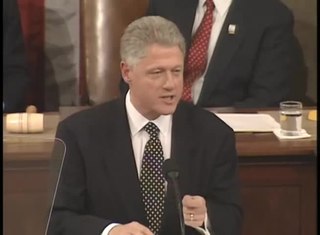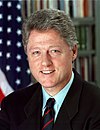Related Research Articles

The State of the Union Address is an annual message delivered by the president of the United States to a joint session of the United States Congress near the beginning of most calendar years on the current condition of the nation. The State of the Union Address generally includes reports on the nation's budget, economy, news, agenda, progress, achievements and the president's priorities and legislative proposals.

Robert Lee Stump was an American politician who served as a U.S. Congressman from Arizona. He served as a member from the Democratic Party from 1977 to 1983 and then later a member of the Republican Party until the end of his tenure as congressman.

Barbara Lynn Cubin is an American politician who was a Republican member of the United States House of Representatives, Wyoming's sole member of that body. She was the first woman elected to Congress from Wyoming.

The 107th United States Congress was a meeting of the legislative branch of the United States federal government, composed of the United States Senate and the United States House of Representatives. It met in Washington, D.C., from January 3, 2001, to January 3, 2003, during the final weeks of the Clinton presidency and the first two years of the George W. Bush presidency. The apportionment of seats in this House of Representatives was based on the 1990 United States census.

Julius Caesar Watts Jr. is an American politician, clergyman, and former football player. Watts played as a quarterback in college football for the Oklahoma Sooners and later played professionally in the Canadian Football League (CFL). He served in the U.S. House of Representatives from 1995 to 2003 as a Republican, representing Oklahoma's 4th congressional district.

A joint session of the United States Congress is a gathering of members of the two chambers of the bicameral legislature of the federal government of the United States: the Senate and the House of Representatives. Joint sessions can be held on any special occasion, but are required to be held when the president delivers a State of the Union address, when they gather to count and certify the votes of the Electoral College as the presidential election, or when they convene on the occasion of a presidential inauguration. A joint meeting is a ceremonial or formal occasion and does not perform any legislative function, and no resolution is proposed nor vote taken.

The 2000 State of the Union Address was given by the 42nd president of the United States, Bill Clinton, on January 27, 2000, at 9:00 p.m. EST, in the chamber of the United States House of Representatives to the 106th United States Congress. It was Clinton's seventh and final State of the Union Address and his eighth and final speech to a joint session of the United States Congress. Presiding over this joint session was the House speaker, Dennis Hastert, accompanied by Al Gore, the vice president, in his capacity as the president of the Senate.

Barack Obama, the 44th president of the United States, addressed a joint session of the United States Congress on Tuesday, February 24, 2009. It was his first public address before a joint session. Similar to a State of the Union Address, it was delivered before the 111th United States Congress in the Chamber of the United States House of Representatives in the United States Capitol. Presiding over this joint session was the Speaker of the United States House of Representatives, Nancy Pelosi, accompanied by Joe Biden, the vice president in his capacity as the president of the Senate.

The 1999 State of the Union Address was given by the 42nd president of the United States, Bill Clinton, on January 19, 1999, at 9:00 p.m. EST, in the chamber of the United States House of Representatives to the 106th United States Congress. It was Clinton's sixth State of the Union Address and his seventh speech to a joint session of the United States Congress. Presiding over this joint session was the House speaker, Dennis Hastert, accompanied by Al Gore, the vice president, in his capacity as the president of the Senate.

The 1998 State of the Union Address was given by the 42nd president of the United States, Bill Clinton, on January 27, 1998, at 9:00 p.m. EST, in the chamber of the United States House of Representatives to the 105th United States Congress. It was Clinton's fifth State of the Union Address and his sixth speech to a joint session of the United States Congress. Presiding over this joint session was the House speaker, Newt Gingrich, accompanied by Al Gore, the vice president, in his capacity as the president of the Senate.

The 1996 State of the Union Address was given by the 42nd president of the United States, Bill Clinton, on January 23, 1996, at 9:00 p.m. EST, in the chamber of the United States House of Representatives to the 104th United States Congress. It was Clinton's third State of the Union Address and his fourth speech to a joint session of the United States Congress. Presiding over this joint session was the House speaker, Newt Gingrich, accompanied by Al Gore, the vice president, in his capacity as the president of the Senate.

The 1995 State of the Union Address was given by the 42nd president of the United States, Bill Clinton, on January 24, 1995, at 9:00 p.m. EST, in the chamber of the United States House of Representatives to the 104th United States Congress. It was Clinton's second State of the Union Address and his third speech to a joint session of the United States Congress. Presiding over this joint session was the House speaker, Newt Gingrich, accompanied by Al Gore, the vice president, in his capacity as the president of the Senate.

The 1994 State of the Union Address was given by the 42nd president of the United States, Bill Clinton, on January 25, 1994, at 9:00 p.m. EST, in the chamber of the United States House of Representatives to the 103rd United States Congress. It was Clinton's first State of the Union Address and his second speech to a joint session of the United States Congress. Presiding over this joint session was House speaker Tom Foley, accompanied by Vice President Al Gore, in his capacity as the president of the Senate.
The 1992 State of the Union Address was given by the 41st president of the United States, George H. W. Bush, on January 28, 1992, at 9:00 p.m. EST, in the chamber of the United States House of Representatives to the 102nd United States Congress. It was Bush's third and final State of the Union Address and his fourth and final speech to a joint session of the United States Congress. Presiding over this joint session was the House speaker, Tom Foley, accompanied by Dan Quayle, the vice president, in his capacity as the president of the Senate.
In American politics, the response to the State of the Union address is a rebuttal speech, often brief, delivered by a representative of an opposition party following a presidential State of the Union address. When the president is a Democrat, the rebuttal is typically given by a Republican, and vice versa.

The 1985 State of the Union Address was given by the 40th president of the United States, Ronald Reagan, on February 6, 1985 — Reagan’s 74th birthday — at 9:00 p.m. EST, in the chamber of the United States House of Representatives to the 99th United States Congress. It was Reagan's fourth State of the Union Address and his fifth speech to a joint session of the United States Congress. Presiding over this joint session was the House speaker, Tip O'Neill, accompanied by George H. W. Bush, the vice president.
The 1991 State of the Union Address was given by the 41st president of the United States, George H. W. Bush, on January 29, 1991, at 9:00 p.m. EST, in the chamber of the United States House of Representatives to the 102nd United States Congress. It was Bush's second State of the Union Address and his third speech to a joint session of the United States Congress. Presiding over this joint session was the House speaker, Tom Foley, accompanied by Dan Quayle, the vice president, in his capacity as the president of the Senate.

Barack Obama served as the 44th president of the United States from 2009 to 2017. Before his presidency, he served in the Illinois Senate (1997–2004) and the United States Senate (2005–2008).
The following is a timeline of the presidency of Bill Clinton, from January 1, 2000 to January 20, 2001.

Bill Clinton, the 42nd president of the United States, addressed a joint session of the United States Congress on Wednesday, February 17, 1993. It was his first public address before a joint session. Similar to a State of the Union Address, it was delivered before the 103rd United States Congress in the Chamber of the United States House of Representatives in the United States Capitol. Presiding over this joint session was the Speaker of the United States House of Representatives, Tom Foley, accompanied by Al Gore, the vice president in his capacity as the president of the Senate.
References
- ↑ Richard E. Sincere Jr. (February 1997). "O.J., J.C., and Bill: Reflections on the State of the Union". Metro Herald. Archived from the original on July 31, 2002. Retrieved January 23, 2007.
Watts told his audience -- about 100 high school students from the CloseUp Foundation watched in person, while a smaller number watched on television at home -- that he is "old enough to remember the Jim Crow" laws that affected him and his family while he grew up in a black neighborhood in small-town Oklahoma.
- ↑ "O.J., J.C., and Bill: Reflections on the State of the Union". Archived from the original on July 31, 2002.
- ↑ Office of the Clerk, U.S. House of Representatives. "Office of the Clerk". Archived from the original on May 13, 2009. Retrieved April 14, 2009.

